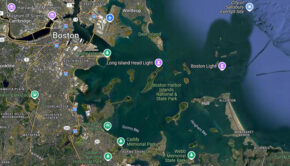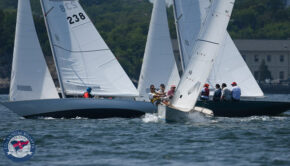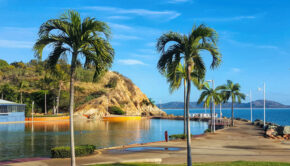Confronting an age-old issue for sailing
Published on September 2nd, 2023
The effort by Frank Quealey in promoting the Australian 18 Footers League is unmatched, and he recently reflected on a vital chapter of history for the iconic skiff. Notably, this was a turning point for the class in which… wait for it… cost and complexity nearly doomed the competition.
With the 2023-24 Australian 18 Footers League season about to get underway with Race 1 of the annual Spring Championship on October 8, it’s time to take a quick look at the success of the rules which changed the style of 18ft skiff racing thirty years ago.
When the Australian and international 18ft skiff fleets of the 1970s fell dramatically throughout the 1980s, the League administrators accepted the responsibility to take up the challenge of getting the local competition numbers back on track while keeping James J. Giltinan’s dream of international expansion alive at the same time.
They saw the overall cost of competition, as well as the regular need to update equipment, was a major reason for the drop in local numbers and the demise of the burgeoning fleets in the UK and USA.
Records show that very few Sydney teams were capable of winning the world or Australian championships and no international team was competitive with the local Sydney teams on Sydney Harbour.
The first move to rationalize the cost of top level competition originally came from Julian Bethwaite, when he produced a competitive boat (B18), for a fraction of the cost of the skiffs of the 1980s, and won both the 1991 World Championship and Grand Prix Sailing circuit.
Bethwaite had shown that championship-winning results could be achieved at a far more cost-effective rate than the sums required in the 1980s-early 90s, and the new concept was the sport’s way of the future.
David Witt, who sailed with Bethwaite, recalls, “We took two B18s to France to contest the European Championship and help grow the class internationally with the new design, which was actually the design from which the 49er and 29er were derived.”
“We met British boat builder Dave Ovington and Julian sent him moulds from which he began to build boats for the Europeans. For a few years, the majority of the world was sailing Bethwaite designed boats.”
Despite the cost involved to the League, club administrators were determined to rationalize the cost of local competition, while raising the competitiveness of both local and international competition at the same time, so they introduced an entirely new set of rules for all future racing at the club and all events conducted/sanctioned by the League.
Basis for the new League rules was a ‘one design’ hull together with a reduction in the number of rigs and sails that each boat could use in one season.
Iain Murray was commissioned to design a suitable hull, which was built from carbon fibre skins over a foam-sandwich core, and with carbon fibre structural supports. Each boat was allowed only two mainsails, two headsails, and two spinnakers.
The new 18 hulls began racing in the 1993-94 season, although a brief transitional period allowed existing Bethwaite B18-style hulls to continue racing. The new 18 first contested the 1994 JJ Giltinan Championship but it wasn’t until 1996, when Stephen Quigley won in AEI-Pace Express, that the new concept had its first victory.
Trevor Barnabas, who retired from the 18 footers after winning the 1987 and 1988 (tied) World championships in Chesty Bond, returned to the 18s in 1995 with his son Trent and, along with Rod Howell won the 1997 Giltinan World Championship in Omega Smeg-2UE.
Later in 1997, the League took the unprecedented decision to send the JJ Giltinan World Championship trophy to Europe where a second championship was sailed for the one-and-only time in the same calendar year. The same Barnabas-led team won its second title in the same skiff, which this time raced as Smeg.
The team won its third consecutive title racing back on Sydney Harbour as Omega Smeg-2UE.
The positive change brought about by the ‘New 18s’ was never more obvious than shown in the comparison between Barnabas’ championship victories, ten years apart, in the 1980s and 1990s.
When Barnabas won the 1987 World Championship on the Swan River in Perth, Western Australia under the old rules, there was a fleet of 22 boats representing Australia, USA, and New Zealand. One year later, on Sydney Harbour, the fleet was 18 boats with competitors coming from only Australia and New Zealand.
In contrast, Trevor’s 1997 Giltinan World Championship victory had a fleet of 28 boats representing Australia, USA, UK, Italy, Slovenia, France, and New Zealand.
International competition on Sydney Harbour at the Giltinan World Championship between 1994 and 2000 came from 14 countries – England, Scotland, Japan, Sweden, USA, New Zealand, Switzerland, Italy, Slovenia, France, Holland, China, Denmark, and Ukraine.
It was the greatest era for international participation in 18 footer history.
The decade ended on an incredible high when the world’s greatest 18 footer championship was won by a skipper from the northern hemisphere following Englishman Tim Robinson’s victory in Rockport, on Sydney Harbour in 1999.
Ironically, David Witt, who was part of the B18 ‘push’ to Europe in the early 90s, was now part of the history-making Rockport team.
According to ‘Witty’, “the League boat was more cost-effective and easier to sail than the B18, especially in the 18-knot-plus range, and allowed a much wider group of sailors to be competitive.
“The result was immediate with the British following suit and leading us to where we are today, with all nations sailing the latest Murray design.”
While 1999’s British victory was a great international result for the 107-year-old class (at that time), the 2000 result was one that brought just as much satisfaction to the long-time supporters of the class when John ‘Woody’ Winning won the JJ Giltinan Championship in AMP Centrepoint, after being runner-up twice to the legendary Iain Murray and the Color 7 team some 20 years earlier.
James Joseph Giltinan’s 1930s dream of international competition in the 18 footers class reached a high in 2002 when a second northern hemisphere nation, this time the USA, won the title following Howie Hamlin’s victory in GE-US Challenge.
When Hamlin repeated the victory in 2003, then England’s Rob Greenhalgh dominated the 2004 regatta in RMW Marine, the unthinkable had occurred. Northern hemisphere countries had just won four of the last six Giltinan World 18 footer championships.
If anyone needed proof of the success for the new rules, surely that was it.
While the League had stabilized the rules around the hull design and the allowable use of sails each season, there was still scope for improvement in hull construction as well as initiatives within the parameters of the rules relating to sails and rigging, to maintain the leading-edge standards within the class.
Two men who have been at the fore-front of the progress over nearly 20 years are Stephen Quigley and Brett Van Munster.
Since Brett Van Munster was appointed class boat builder in 2006, his outstanding construction ability and techniques have dramatically changed the quality and longevity of the high-performance hulls. New hulls were once critical for success in major championships, but Brett’s skill has changed this to where the present-day hulls are so well built that the longevity of a championship-winning hull has been increased to around 5-6 seasons.
Van Munster’s simple explanation of the highly technical, and very precise, building process he uses: “Our challenge is to build boats which are very light, yet strong enough, to meet the high demands of 18ft Skiff Racing. We only have a small team but we’ve got the expertise to work with the same materials as those used in Formula One Racing and the aircraft industry.”
International competition has continued with six more nations (South Africa, Portugal, Canada, Germany, Brazil, and Hungary) contesting the JJ Giltinan 18 Footer Championship on Sydney Harbour since 2000.
It brings to 21 the number of nations that have challenged for the world’s greatest 18 footer championship, since the first regatta in 1938.
History was created in 2013 when two all-girl teams contested the championship as Alexandra South, Lizzi Rountree, and Saskia Tidey sailed for Australia, while Katie Love, Christine Neville, and C.C. Childers represented the USA.
The UK’s Andy Budgen and USA’s Katie Love took their challenge to another level. Andy sailed three complete Sydney seasons (2008-09, 2009-10 and 2010-11) in his Project Racing skiff, while Katie returned, after her all-girl team challenge, and spent the entire 2018-19 season in Sydney as skipper of Panasonic Lumix.
Despite the increased challenge of the 2000s, local Sydney teams won all but three regattas between 2001 and 2017.
John Harris (Rag & Famish Hotel 2001), Euan Mc Nicol (Club Marine 2005 and Southern Cross Constructions 2009) and Lee Knapton (Smeg 2016) each won titles, but it was Michael Coxon and Seve Jarvin who dominated the winners list during the 17-year period.
Michael Coxon won four Giltinan World championships for four different sponsors. Casio Seapathfinder in 2006, Fiat in 2007, Thurlow Fisher Lawyers in 2017 and Smeg in 2021.
Seve Jarvin has a total of 10 Giltinan World Championship victories – the greatest number of any competitor in the championship’s history. He won seven as skipper of Gotta Love It 7 skiffs, between 2008 and 2015, and once as skipper of Andoo in 2022, and was sheet hand on Club Marine in 2005 and Andoo in 2023.
New Zealand was the only nation to compete against Australia in the original world championship regatta in 1938 and proved to be wonderful designers, innovators, and competitors over the next 40 years. Kiwi teams scored seven victories before the New Zealand challenges were reduced in entry numbers and competitive teams by the early 1980s.
Following a drought of nearly forty years, champion 18 footer competitor of the 1970s, Graham Catley spear-headed a campaign to return New Zealand back to the glory days of winning Giltinan world championships.
Realizing that costs associated with a competitive campaign were now much less than before the introduction of the new rules, Catley organized sponsorships and commissioned Van Munster to build five new hulls as the first stage of his plan. Fellow kiwi, Alex Vallings was critical to the rigging and the only thing left to do was select up-and-coming champion young sailors.
His belief and determination were rewarded in 2018 when David McDiarmid and his Honda Marine team won the first of its three consecutive victories. Only COVID-19 stopped the Honda Marine team from possibly increasing their winning run beyond 2020.
The New Zealand revival was another big tick for the success of the ‘new 18’ concept.
COVID also had a dramatic effect on the international participation at the JJ Giltinan Championship regattas but as we look towards the coming 2023-24 season and the 2024 Giltinan Championship in March, the scene is already beginning to heat up with the prospects of more international teams on their way to challenge the present champion Andoo team of John Winning Jr, Seve Jarvin, and Sam Newton.
Along with a strong challenge from the Brisbane-based Queenslanders, there are already prospects of international teams from Germany, Sweden, Japan and a return of the New Zealanders.
The success of the decision made by the Australian 18 Footers League those 30 years ago can be directly attributed to the efforts and financial contribution of the League, which has funded the program to rebuild local racing, promote and assist international competition, and produce live stream video coverage of its racing on Sydney Harbour to the world.
The current Australian 18 Footers League President John (Woody) Winning, fully supported by the expertise and commitment of his Board of Directors, has been a central part of the club’s program and its capacity to fund the program over the full 16-year term of his presidency.









 We’ll keep your information safe.
We’ll keep your information safe.